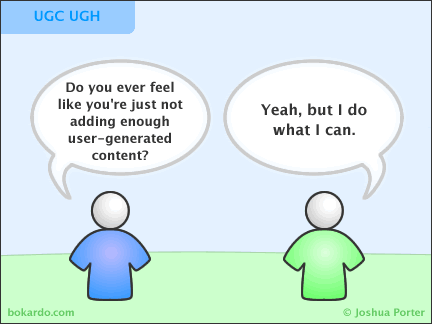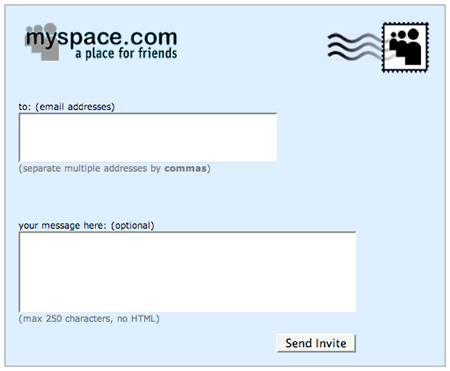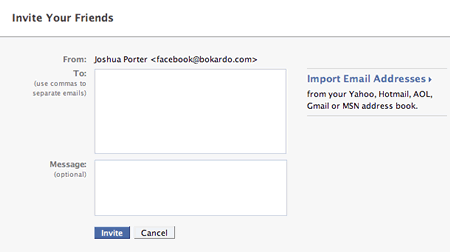August 7th
Comic: Are you adding enough user-generated content?

Continue Reading: Comic: Are you adding enough user-generated content?
TAG: Social Design
August 7th

Continue Reading: Comic: Are you adding enough user-generated content?
August 7th
I’m introducing a new type of post here at Bokardo called “Interface Compare”. I’ll use it to compare interfaces from different services to highlight interesting things designers are doing (or not doing). The first installment is comparing the Invite screens on MySpace and Facebook.

The interface for this is pretty straightforward. You can type in the email addresses of all the friends who you would like to invite, separated by a comma. You can also add a message to the invite if you want.

You’ll notice one big difference between the Facebook and MySpace invite screens. Facebook allows you to import addresses from various third party email systems. You can grab your contacts from webmail services such as Gmail, Yahoo Mail, and Hotmail. You can also import contacts from your desktop mail applications as well.
Continue Reading: Interface Compare: Inviting Friends on MySpace & Facebook
August 3rd
The Microsoft Zune and the web site that promotes it are an excellent example of not following The Del.icio.us Lesson as they put social value above personal value. We just don’t get an answer to the question “What’s in it for me?”, and as a result the Zune will most likely continue to fail.
Here is a snippet from the Zune site:
Mama always said to share. Now you have an opportunity to do it with music and photos. With wireless Zune to Zune sharing you can send your favorite tracks and photos to friends.
Picture this: You’re walking down the street. Or you’re in a room with a bunch of friends. Or at a concert. Or at the airport. Or on the bus (you get the picture) and then you whip out your Zune and see all these other Zune devices around that you can choose from. Zap! You’re connected to your best friend and send the new song your band recorded in the garage last weekend. Another friend gets the hilarious podcast your kid brother made at school, plus that song you just downloaded from the Zune Marketplace and can’t get out of your head. And hey, lookee here, your friend wants to send you something that you might like and buy, too.
Best of all, the song you sent isn’t just a 30-second preview—it’s the whole song! Your friend can sample the song up to three times in three days, flag it on their device and then, if they like it, they can buy it later from Zune Marketplace. It’s all connected.
It’s all connected! Wahoo! Doesn’t it sound like my friends are having more fun than me? Their happiness sounds much more important than mine here.
Continue Reading: Why the Microsoft Zune is Set up to Fail
August 1st
Luke Wroblewski shares a discussion on the ambiguous role of the designer:
Client: “Performance metrics, market landscape, product strategy? You don’t sound much like a designer. Shouldn’t we be discussing color options and page templates?”
Designer: “Design is the physical, or in this case digital, manifestation of your product strategy. Of course we could define your customers’ experience with ‘paint by number’. But I think you’d agree we should figure out what you want to say to your customers and why before we dive into how we’re going to say it.”
There are two ways to view Design here.
If you view it as creating interfaces to content, then you might stop short of talking about strategy. Instead, you would focus on how to display what you’ve got. Typography, grids, information hierarchy, big buttons, huge fonts, navigation bars, etc.
The other view that Luke alludes to is one that I believe we are moving toward, necessarily: having the designers in the strategy discussion alongside the “business strategy” people talking about the “what” as well as the “how”. (btw: this is the “strategy” part of the Bokardo Design: Interface design & strategy for social web applications). I would be doing both myself and my clients a disservice if I ignored how their business strategy can drive the design. A designer has done their job well when they have created an honest implementation of that business strategy.
Continue Reading: How does Strategy affect Design?
July 25th
I’m speaking about social design at a few events in the coming months. Hope to see you there!
User Experience Week 2007
August 13-16, 2007 – Washington DC
Under the guidance of experienced practitioners from Adaptive Path and other top companies, this four-day conference introduces user experience practitioners to new rich internet application design approaches, practical prototyping techniques, effective cross-organization communications strategies and more.
Use the promotion code UXJP to save 15% on the registration rate.
User Interface Conference 2007
November 5-8, 2007 – Cambridge, MA
Get ready to learn side-by-side with world-renowned experts at User Interface 12. Nowhere else will you have the chance to spend full days learning from top design and usability authorities. UIE’s Jared M. Spool and his team of usability researchers created User Interface 12 for designers, information architects, and usability professionals who need to tackle their biggest design challenges.
Continue Reading: Upcoming Speaking Events
July 24th
One of the emerging principles of social design is what I call The Del.icio.us Lesson, which can be summarized as “personal value precedes network value”. Since I wrote about the Del.icio.us Lesson last year, it has become one of my most read and cited posts.
Other evidence would suggest that there’s something to it as well, that it is indeed a strong principle that helps us build better social software. Several of the social design folks that I regularly read, including Thomas Vander Wal and Rashmi Sinha, have observed similar phenomena. In a talk she gave about social design at Wordcamp, Rashmi’s first principle was “Make the system personally useful”. You can see her slides here.
Now, it’s one thing to talk about the importance of personal value and how that personal value precedes network value, but just what does the Del.icio.us Lesson mean in practice? That’s what this series of posts is about…
Continue Reading: Putting the Del.icio.us Lesson into Practice, Part I: The Cold-Start Problem
July 19th
It’s not everyday that Seth Godin writes something that has anything to do with social web apps, so his post today got me really excited. In Jobs of the future, #1: Online Community Organizer he writes:
“What if you want to hire someone to build an online community? Somebody to create and maintain a virtual world in which all the players in an industry feel like they need to be part of it? Like being the head of a big trade association, but without the bureaucracy and tedium…
It would help if that person understood technology, at least well enough to know what it could do. They would need to be able to write. But they also have to be able to seduce stragglers into joining the group in the first place, so they have to be able to understand a marketplace, do outbound selling and non-electronic communications. They have to be able to balance huge amounts of inbound correspondence without making people feel left out, and they have to be able to walk the fine line between rejecting trolls and alienating the good guys.
Continue Reading: Seth Godin’s Job #1: Community Management
July 19th
You’ve probably heard the term “stream” in relation to attention, as in “attention stream”.
The usage of the word is spreading, however, and is now finding its way into web application vernacular. It is called a “lifestream”, “socialstream”, “friendstream”, “contentstream”, among others.
It has come to mean a list of the always-updated items in a system. Here are a few examples:
It should be apparent that almost any items updated in real-time can constitute a stream. And therefore a stream can be used in almost any application that people use. The question is: is it useful to see a list of what you’ve done or what you’re friends are doing? In many cases, it is at least interesting, if not useful.
Continue Reading: Welcome to the Stream
July 17th
Guy Kawasaki wrote a nice post The Nine Best Story Lines for Marketing, about an interesting book called Beyond Buzz: The Next Generation of Word-of-Mouth Marketing. The book outlines 9 major themes of the topics that people talk about, write about, and care about.
Continue Reading: What Do People Talk About?
July 16th
Over the past several months I’ve been receiving many requests for designing social web applications. After all, designing social web applications is the topic of this blog, so it makes sense that folks would assume I do design work. Since I’ve had a full-time job, however, I haven’t been able to offer services…I’ve only been able to write about my observations and ideas with you all.
It was frustrating, however, because social web apps are the future of software and I felt sort of on the sidelines from a design standpoint. At UIE we work on some great projects, such as a recent social web app where we’re doing some cool research on how people are using it, but I still heard the call of those Bokardoans who would ping me and say “Hey, we’re working on this cool thing…” The responsibilities of my current job (which is a great job, btw) forced me to say “Sorry, I can’t help” over and over again.
But that’s about to change. I’ve decided to start a company: Bokardo Design. I’m going to offer the exact services that I write about here at Bokardo: Interface design and strategy for social web applications. For those of you who have read Bokardo for a long time, nothing that I offer will be a surprise. I’m simply putting into practice what I’ve been preaching…so to speak.
Continue Reading: Seizing the Opportunity: Bokardo is becoming a design company